Give and Take
Give and Take: A Revolutionary Approach to Success
by Adam Grant
Penguin Group (2013) (public library)
Summarized by Joshua Elle

Overview
Adam Grant combines personal accounts and contemporary research, both made readily accessible, to build a case for thinking of people as takers, matchers, and givers. He shows how givers tend to rise to the top of the success ladder.
Application to Ethical Systems
Grant tells us how to foster an environment that (1) supports givers, (2) encourages matchers and takers to transform into givers, and (3) precludes or eliminates takers altogether. He provides a strong foundation for designing a system that will increase personal fulfillment for those operating in it and facilitate long-term positive outcomes for all.
Chapter Summaries
Chapter 1: Good Returns—The Dangers and Rewards of Giving More Than You Get
The oft overlooked variable of success that Grant focuses on is how people approach their attitudes and interactions with other people; whether they claim value or contribute value, and what their preferences are for reciprocity. Are they takers, givers, or matchers?
Grant describes takers as the kind of people who get more than they give, tilting reciprocity in their favor. They can be called cautious or self-protective, usually adopting the popular idiomatic thinking of “looking out for number one” in this “dog-eat-dog world.”
Matchers are more comfortable operating on the principle of fairness, interacting in a tit-for-tat way that balances reciprocity.
Givers give more than they get, tilting reciprocity the other’s direction. They are other-focused and privilege consideration of benefits to others over costs to themselves.
Interestingly, individuals might shift their approaches depending on professional or personal relationship contexts. For instance, someone may be a giver with friends and family and a taker with coworkers.
Across occupations, people identified as takers and matchers land in the middle ranges on scales of success, whereas those identified as givers land at the bottom and the top.
Chapter 2: The Peacock and the Panda—How Givers, Takers, and Matchers Build Networks
Grant argues, “that while givers and takers may have equally large networks, givers are able to produce far more lasting value through their networks, and in ways that might not seem obvious.”
Modifying a Dutch phrase, Grant explains that, “takers rise by kissing up, but they often fall by kicking down.” Studies show that takers are punished by others who share reputational information (i.e., bad experiences) after being burned.
It is important to prevent takers from rising to positions that can topple whole systems. Signs of being a taker include using more first-person singular pronouns like I, me, mine, my, and myself, especially when explaining one’s own success. A greater disparity in compensation of CEOs was found to be a sign of a taker. Another sign is the prominence of a CEO’s image in annual reports.
With the rise of social media and online social networking, networks are becoming more transparent, and it is easier to spot takers. While the more strict-reciprocity styles of takers and matchers lend themselves to discomfort and vulnerability (e.g., keeping a ledger of favors given and owed), the giver’s style of reciprocity avoids these scenarios by being longer-term, often open-ended, and focused on how other people can be helped. This kind of giving is exemplified by a Silicon Valley entrepreneur, Adam Rifkin, who has adopted the five-minute favor philosophy that “you should be willing to do something that will take you five minutes or less for anybody.”
Grant goes on to contrast the quality of our social network ties, and he illustrates the advantages of relying on our weak ties and reconnecting with our dormant ties. These ties offer access to novel information. In addition, dormant ties have retained the element of established trust. Reactivation of dormant ties comes easiest to givers.
In sum, operating in a karmic-like system governed by a pay-it-forward ethos, givers are able to develop and leverage their networks to greater benefit to both those they know and themselves.
Chapter 3: The Ripple Effect—Collaboration and the Dynamics of Giving and Taking Credit
Research shows that superstar surgeons’ and investment analysts’ success is significantly dependent on the teams in which they operate.
Grant illustrates how interdependence can be a strength to givers and their teams, while a taker’s independence can undermine a team’s performance. With givers, the quantity and quality of products and services increases, and successful givers expand the pie for everybody. Also, by sacrificing themselves to the group, those givers gain latitude to push the status quo when they want to introduce a new idea or implement a new strategy for the group.
On the other hand, when takers claim sole credit for their team’s performance, they are punished. This claiming of sole credit can stem from the responsibility bias (an exaggeration of one’s own inputs relative to others) and/or the perspective gap (a dramatic underestimation of the effect upon ourselves or others of a physically or psychologically intense state which we are not experiencing). Givers are better than takers at countering the responsibility bias by clearly understanding the contributions of others; they are also better at crossing the perspective gap by finding ways to put themselves in other people’s shoes. Crossing the perspective gap creates an environment of psychological safety, which increases reporting of errors and decreases committed errors. Whereas genius takers can be stifled in realizing their genius, givers can better facilitate the genius of others and so become “genius makers.”
Chapter 4: Finding the Diamond in the Rough—The Fact and Fiction of Recognizing Potential
The Pygmalion effect, or self-fulfilling prophecy, where teachers’ or leaders’ perceptions of their students or subordinates come to be fulfilled, has proven true in numerous settings ranging from the classroom to military training to various business contexts. Grant cites Brain McNatt, management researcher, who encourages managers to “recognize the possible power of influence in (a) having a genuine interest and belief in the potential of their employees… and (b) engaging in actions that support others and communicate that belief… increasing others’ motivation and effort and helping them achieve that potential.” (101).
Grant also goes on to challenge the stricture that success depends upon talent first and motivation second. Findings support that motivation is in fact the catalyst of the development of talent. By making tasks more interesting and motivating, grit is cultivated. Grit is “having passion and perseverance toward long-term goals” (105-6). Givers, as teachers, have a propensity for seeing the potential for talent in others, and for helping them to cultivate grit.
While it might seem that givers are more susceptible to making bad decisions by overinvesting in people who don’t achieve their potential, the opposite is true. Grant examines the categories of bad investment decisions: (1) escalation of commitments as a consequence of the “sunk cost fallacy,” or bias to previous investment; (2) anticipated regret; (3) project completion; and (4) ego threat. In all cases, takers are more susceptible to bad decision-making, while givers, with their focus on others, are less vulnerable.
Chapter 5: The Power of Powerless Communication—How to Be Modest and Influence People
Rather than establishing dominance by attempting to show strength, power, and authority, givers tend to employ “powerless communication” strategies when trying to influence others. “Powerless communicators tend to speak less assertively, expressing plenty of doubt and relying heavily on advice from others. They talk in ways that signal vulnerability, revealing their weaknesses and making use of disclaimers, hedges, and hesitations.” (130-31).
Making oneself vulnerable can be humanizing, and endearing, but it is effective in building standing only when that vulnerability is unrelated to competence. For example, givers in sales might ask their customers questions about themselves, their interests, and their desires, thereby building trust and gaining knowledge about their customers’ needs, leading to increased prestige.
Tactics to Earn Respect and Gain Influence:
| Tactic | Result |
| Using tentative markers such as: hesitations (well, um, uh); hedges (kinda, sorta, maybe); disclaimers (this may be a bad idea, but); tag questions (that’s interesting, isn’t it?); and intensifiers (really, very, quite) | Signals a willingness to defer to others and take others’ opinions into consideration. |
| Seeking advice | Conveys respect and admiration for others’ insights and expertise. |
| Seek help | The act of helping others leads people to feel more positively toward those they are helping. In order for the strategy of advice seeking to work, it must be genuinely sought.
|
Chapter 6: The Art of Motivation Maintenance—Why Some Givers Burn Out but Others Are On Fire
Grant differentiates two types of givers: those who can be considered pathologically altruistic, whose giving is to their detriment, and those who avoid self-sacrifice with an “otherish” focus. “[W]hen concern for others is coupled with a healthy dose of concern for the self, givers are less prone to burning out and getting burned – and they’re better positioned to flourish” (158).
According to Grant, some ways of positioning oneself to flourish include:
- Strengthening the emotional grasp or perception of the impact of giving. For example, connecting the giver to the recipients in a personal and meaningful way (e.g., have an auto engineer meet new auto owners).
- Changing the context for the same act of giving to bring renewed energy.
- Chunking acts of giving together in a single day rather than throughout a week produces a more vivid and dramatic impact on happiness levels.
- Volunteering 100 hours a year, or 2 hours per week, because “that appears to be the range where giving is maximally energizing and minimally draining” (173).
- Acting out of a sense of engagement and purpose rather than duty and obligation.
- Building social networks to give and receive support, taking advantage of the brain’s natural stress response to bond with others in difficult times.
Studies show that givers build willpower much like building muscles. This leads those who give more to earn more, and not just monetarily. They receive a warm glow of giving—a helper’s high—that contributes to increased happiness, allowing for harder and smarter work. “Ironically, because concern for their own interests sustains their energy, otherish givers actually give more than selfless givers.” (185).
Chapter 7: Chump Change—Overcoming the Doormat Effect
Grant makes the case for using an “otherish” approach to avoid becoming a doormat, suffering from being too trusting, too empathetic, and too timid.
Easily trusting other people makes givers susceptible to those takers or fakers who don the trappings of a giver. Snap judgments won’t help you discern whether or not someone is a genuine giver; indeed, agreeableness is too often confused for a sure indicator of a giver. Additionally, givers might easily fall into an empathy trap, imagining another person’s distress and becoming concerned before that person’s true motives come to light. In this way, givers can be overly timid in asserting themselves and advocating for themselves.
In order to combat these weaknesses, Grant recommends having a flexible reciprocity style. This entails having trust as a default assumption, but being ready to occasionally employ matching strategies when confronting a taker. He calls this a “generous tit for tat approach.” Thus, before any loyalty sets in, one should use sincerity screening to judge others’ motives. Rather than dwelling on what another person feels, screening entails focusing on what the other person’s thoughts are; i.e., being empathetic in the head and not in the heart.
For those who suffer from timidity, Grant goes on to suggest taking advantage of the “advocacy paradox.” According to the advocacy paradox, people become more assertive advocates when they are advocating for others, and not only themselves.
Chapter 8: The Scrooge Shift—Why a Soccer Team, a Fingerprint, and a Name Can Tilt Us in the Other Direction
“[I]n group settings, there’s a different way for givers to make sure that they’re not being exploited: get everyone in the group to act more like givers” (219).
Even when giving for selfish reasons, people generally begin caring about those they’re helping. Grant argues that helper’s motives to help are a cocktail mix of selfishness and altruism.
A cornerstone for creating a giving group is establishing a common ground, or activating a common identity. People are more likely to help others with whom they share uncommon commonalities. Put differently, there should be an optimal distinctiveness that balances people fitting within a group with standing out from other groups in a unique way. Additionally, group members benefit from having role models within their group to provide a sense of elevation: that warm feeling of being moved by others’ acts of giving. These role models should be attainable and relatable; i.e., not at a superhuman level.
Giving should be highly visible to further promote giving. In a number of studies, people wrongly reported what motivated the greatest change in their behavior: the behavior of similar others influenced them the most. Grant builds on these findings by presenting the idea of instituting what he calls a “Reciprocity Ring.” This is a group where all individuals make requests to the group, and the group members do what they can to help. The reciprocity ring is designed to disrupt the self-fulfilling prophecy that givers believe they are in the minority, surrounded by takers and matchers. In a reciprocity ring, givers no longer suppress or disguise their giving tendencies, and the takers and matchers in the group follow suit to match the group norms.
Research demonstrates that external incentives such as promotions based on giving behavior and public pledges to be more giving are ineffective. However, as long as there is a generalized giving system where people have a free choice to give, the tendency for people to become givers increases along with sense of identity within the group. Thus the key is to change behaviors first; attitudes will follow.
Chapter 9: Out of the Shadows
“Whereas success is zero-sum in a group of takers, in groups of givers, it may be true that the whole is greater than the sum of the parts” (258). Grant concludes that functioning in the giver’s reciprocity style will lead down a path “marked by greater success, richer meaning, and more lasting impact” (259).
ACTIONS FOR IMPACT
1.) Test Your Giver Quotient
2.) Run a Reciprocity Ring
3.) Help Other People Craft Their Jobs, or Craft Yours to Incorporate More Giving
4.) Start a Love Machine
5.) Embrace the Five-Minute Favor
6.) Practice Powerless Communication, but Become and Advocate
www.theintrovertedleaderblog.com and
7.) Join a Community of Givers
http://thekindnessoffensive.com
www.bni.com and
8.) Launch a Personal Generosity Experiment
www.good.is/post/the-good-30-day-challenge-become-a-good-citizen
http://sashadichter.wordpress.com and
9.) Help Fund a Project
10.) Seek Help More Often





